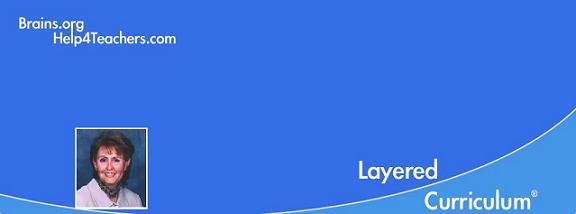__________Layered Curriculum®. . . because every child deserves a special education™_
 |
|
![]() _
_ ![]()
Layered
Curriculum TEXT & WORKBOOK
Set
for only
$43.95
(free shipping in
US)
Tweet
Layered Curriculum®, in a nutshellBy Dr. Kathie F. Nunley
One of the best aspects of Layered Curriculum is its flexibility. The model was designed to be very open, to allow for you to fit it to your teaching style and the needs of your particular classroom. Remember, you only need 3 components to make a Layered Curriculum classroom:
Choice
Accountability
Promote Higher and More Complex Thinking
That's it! There are many, many ways to accomplish these components.
When you add Choice, remember it doesn't have to be in every learning objective. Look for places to add choice whenever possible. Start by adding a choice in homework one day this week, or a choice in what type of quiz a student takes. Ultimately you want to move up to providing choices in HOW they learn the specific learning objectives for your course.
The Accountability piece involves you looking for ways to hold students accountable (the awarding of marks or points) for the actual learning of the objective, not just "doing the assignment". This adds tremendous transparency to your classroom. Let students be aware (preferably in a written form) of what they are expected to know or be able to do in order to pass off that objective. Then after they complete the assignment, have them prove or demonstrate they learned it. I like Oral Defense, but it is not an essential component to a Layered Curriculum classroom, so don't let that overwhelm you.
To promote higher and more complex thinking, we add layers. Everyone starts at the bottom layer with the more simple types of thinking - rote, basic facts, etc. Then everyone progresses through layers, each requiring a more complex thought process. The actual assignments do not need to be more complex, but the thought process does. In Layered Curriculum, this is accomplished by hooking your grading scheme into the layers. So students must progress throughthe layers in order to improve their grade in the unit of study.
And one final reminder - all students should be expected to attempt all the Layers.
For more detailed information, read the text "Layered Curriculum" or the new supplement "Enhancing your Layered Curriculum Classroom".
About the Author:
Dr Kathie Nunley is an educational psychologist, researcher and author of several books on parenting and teaching, including A Student's Brain (Brains.org) and the best selling, "Differentiating the High School Classroom" (Corwin Press). She is the developer of the Layered Curriculum® method of instruction and has worked with parents and educators around the world to better structure schools to make brain-friendly environments. In addition, her work has been used by the Boeing Corporation, Family Circle Magazine, the Washington Post, and ABC television.
Email her: Kathie (at) brains.orgCopyright © 1998 - current year by Kathie F. Nunley.
All Rights Reserved.
Layered
Curriculum is a registered trademark developed by
Dr. Kathie F. Nunley.